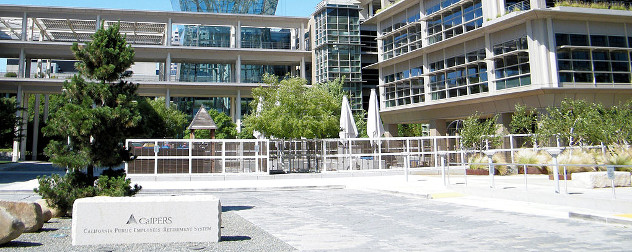
CalPERS headquarters at Lincoln Plaza in Sacramento, Calif. Photo by Coolcaesar at English Wikipedia.
America’s largest pension fund, the California Public Employees’ Retirement System, is admitting that it has been wrong about its expectations for long-term investment performance.
CalPERS is right that it has been wrong, but odds are good that its new position is still wrong anyway.
The Wall Street Journal recently reported that top officers at CalPERS want to abandon their long-held investment target of a 7.5 percent annual return. The proponents of this move cite the very real truth that such an assumption is wildly unrealistic in the current environment. The problem is that the proposed replacement figures – either 7 percent or 7.25 percent – are not necessarily any better. In fact, it’s likely that they are just as misguided as the current assumption.
The fault doesn’t really lie with CalPERS, however. The underlying problem is with the entire concept of pensions – the idea that we can, with a high degree of accuracy, make a promise today to pay an individual a fixed amount for a period that will begin many years in the future, and which will last many years more once the payout period begins, and that we will never run out of money to fulfill that promise.
It’s like asking the Cleveland Cavaliers to make a legally binding promise to win a certain number of NBA championships in the next 20 years. Even if you assume LeBron James is a good enough player to get you a championship – he has done it enough times in enough cities by now to make that a credible assumption – how long will LeBron James play, and how long will he play like LeBron James? How many more players like LeBron James can the Cavaliers acquire? How many LeBron James equivalents, if any, will play for other teams in that time?
All this is unknowable. But if the law required the Cavaliers to come up with an estimate, well, they would come up with some kind of estimate. And as time passed and it became obvious that the estimate was wrong, they’d change that estimate. It would probably still be wrong, over and over again, pretty much up until the time when all the relevant facts were a matter of history and an estimate was no longer necessary.
CalPERS is in a similar bind. It knows two things. One is that, over long periods of time, the stock market as a whole (reflected in broad-based indexes or other samples) generates returns in excess of inflation. (Over the short term, market movements are nearly impossible to accurately predict, but wise pension management should disregard short-term movements as irrelevant noise anyway.) The other is the amount of money that California cities and other public employers in the CalPERS system have promised to pay their current and future retirees at some later date for services they either have already rendered or will render in the near future.
CalPERS bases the funding requirements it sets for those participating governments and employers on its estimates of how well investments will perform and on a host of other factors, including how soon those employees will retire and, crucially, how long they and their beneficiaries will live to collect the pensions they earn. A pension fund is not supposed to just pay benefits until the money runs out and then send a letter that says, “So sorry – we’re done.”
But CalPERS has no idea what level of inflation to expect in the years and decades to come. More inflation is actually better for CalPERS, for a couple of reasons: Beneficiaries’ pensions usually don’t automatically and fully adjust upward, and stocks will usually generate a higher nominal return to compensate for that inflation. Basically, the real value of future benefits gets smaller as inflation gets bigger, and smaller benefits are more affordable than bigger benefits.
But we have just lived through more than a decade of low inflation that continued to get even lower, rather than higher. This not only tends to depress long-term stock returns, but it also has resulted in historically low interest rates. A pension fund’s portfolio does not usually consist only of stocks; typically, interest-bearing bonds also make up a significant part. But there has been little interest to be earned in reasonably safe bonds in this environment. Rates are rising now, but that actually depresses the value of bonds in a fund’s portfolio and makes the funding shortfall look even worse.
Fixed pension funds like CalPERS are asked to take a collection of unknowable uncertainties and assemble them into a known, fixed and solid promise. It can’t be done. Or more accurately, it can’t be done at a cost that those who fund pensions are reliably willing to pay. Even if you tried to collect the entire amount of the future pension payments up front and just put the money in a vault, future increases in life expectancy could leave you short. And if an employer is willing to fork over the entire value of the pension payment up front, why not just give it to the employee outright in a profit sharing plan or as a current bonus?
This is why pension funds are vanishing in the private sector – commercially, they just don’t work. They don’t work in the public sector either, but that sector has been much slower to change because public entities are insulated from commercial realities, at least to a degree. But they are not insulated from economic reality.
So CalPERS was wrong before, it is probably wrong now, and it will undoubtedly be wrong again when it eventually changes its assumptions. But don’t blame CalPERS for not having a crystal ball that nobody has invented yet. Blame a system that calls on pension administrators to consult their crystal ball and act accordingly.












December 23, 2016 - 2:48 pm
So if I understand the Republican Legislature is crying about what is ultimately failure of California’s Legislature to do its job. Pay raises were refused and enhanced retirement benefits were granted instead. So WHO kicked the can down the road? Answer: They did. Who granted years that contributions were allowed to be reduced……wait it was the legislature. California residents are getting what they wanted with who they elected.
So please lay blame where it belonigs…..The Legislature!!!!